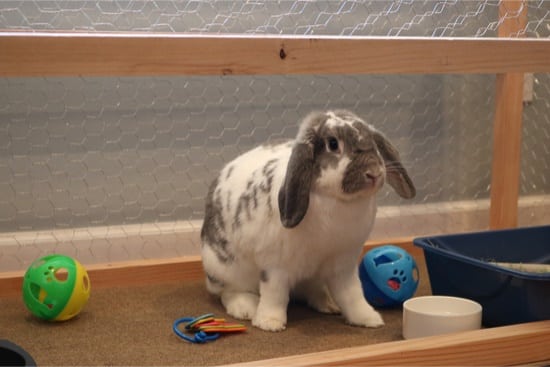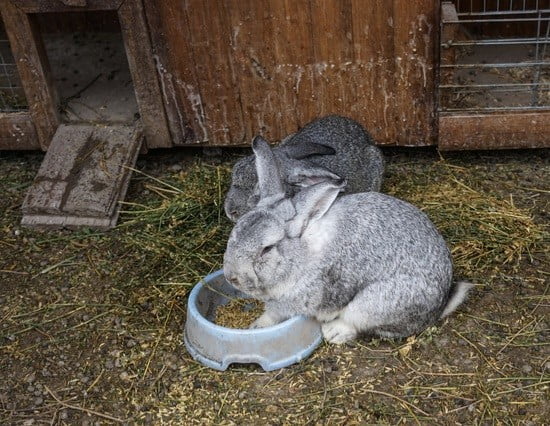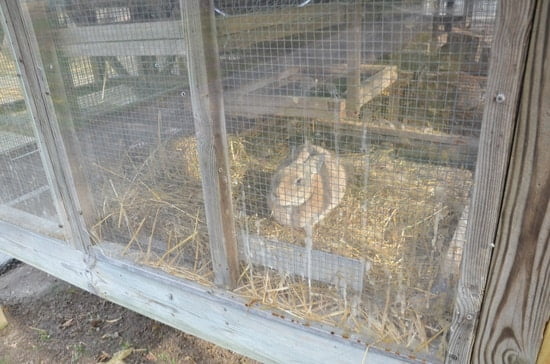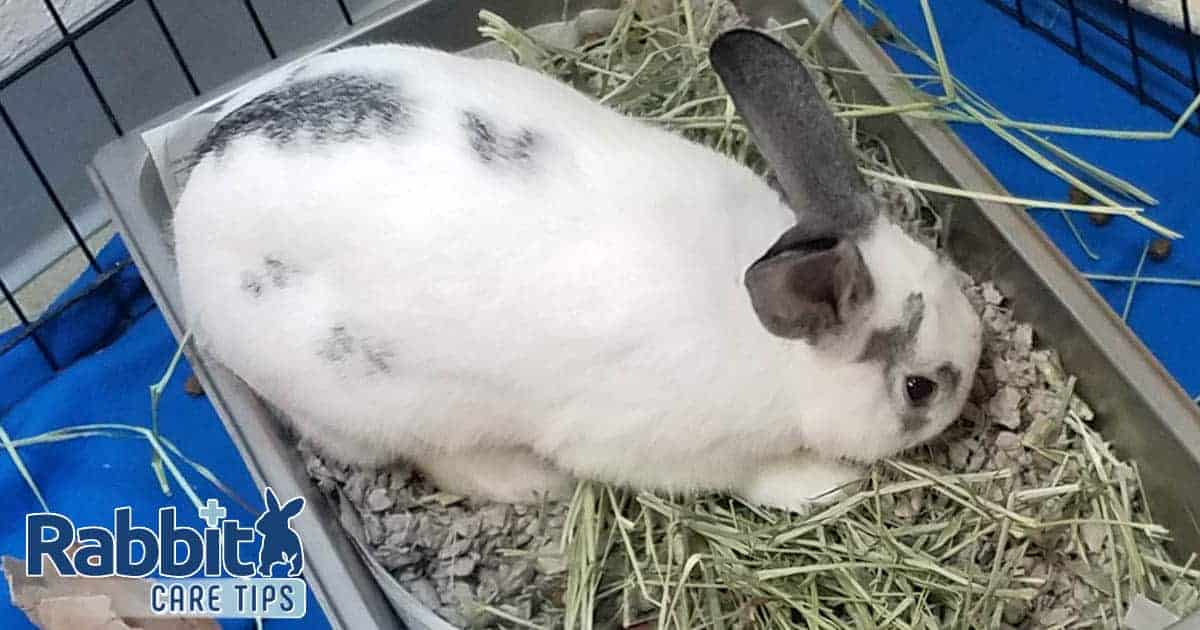Litter training a rabbit in a hutch is recommended to all pet owners. Rabbits are territorial animals, and they’ll urinate all over your home. If you’ve experienced the strong stench of rabbit urine, you’ll want to train a rabbit to use a litter tray so that it doesn’t happen again.
Rabbits are clean and have a favored urination spot in their hutch. Apply a tray to this location, filled with soiled hay. Your rabbit will usually follow its nose and pee in the litter tray.
Litter training a rabbit can require time and patience. Some bunnies treat their litter tray as a bed, and others dig at it constantly. The tray must also be the right size and shape, and the litter must be safe. This guide explains all you need to know about litter training your pet rabbit.
Can All Rabbits be Litter Trained?
It’s possible to litter train any rabbit breed. Older rabbits are more responsive to training, though. Spaying or neutering your bunny makes life considerably more manageable, too.
If you adopt a bunny younger than six months, litter training can be a challenge. Baby bunnies have immature brains and bladders. They also have an attention span of virtually zero.
On the flip side, once a rabbit reaches breeding age, they become considerably more territorial. They’ll mark territory any way they can, and spraying urine will become commonplace.
As Park Vets explains, spaying or neutering will curb these instincts. A fixed rabbit will be more docile than their sexually active counterparts. They’ll also be more receptive to litter training.
Is Litter Training a Rabbit Essential?
Rabbits are clean animals, and will usually stick to one corner of their hutch for elimination.
This doesn’t help you if you let your rabbit play and exercise in the house, though. Without litter training, a bunny sees your home as their urinal.
Litter train a rabbit for their safety. If a rabbit eliminates into their hay, they could become unwell. A rabbit that is not litter trained risks developing urine scald (wet tail.) Exposure to urine will also cause a rabbit’s fur to turn yellow.
What is Urine Scald in Rabbits?
Urine scald occurs when rabbits sit and wallow in their own waste. While commonly associated with disabled or immobile bunnies, it can also impact a healthy rabbit.
If a rabbit is exposed to their urine, it will burn and inflame their skin. This is painful, and leads to a loss of fur around the hindquarters. Litter training a bunny reduces this risk.
If you do notice urine scald on your rabbit’s rear, treat it with a topical ointment. Any pet store will stock a range of these treatments.
Prevention is always better than cure, though. Litter trained rabbits are less likely to be exposed to their own urine for prolonged periods.
What’s the Best Litter Tray for My Rabbit?
Before you start litter training your rabbit, you need to pick up the appropriate equipment. The litter tray itself is the most pivotal item.
The size of the litter tray is essential. If their tray is too small, a rabbit will not use it. The tray should be big enough to host your rabbit and hay comfortably. Rabbits like to eat while they eliminate.
An average-sized rabbit will be content with a litter tray that measures 15” x 10”. If you have a larger breed of rabbit, this must be taken into account.
Think about the height of the litter tray. Most rabbits pee by lifting their tail over the edge of the tray. If it’s too low, the urine will dribble down their leg and cause scalding. The ideal litter tray will be at least 6” tall.
The exception to this is rabbits with mobility issues. Older pets may struggle to hop the 6” required to poop in their tray. If this applies to your bunny, consider a litter tray with one low side.
You may find that rabbit-specific litter trays fail to satisfy these criteria. Storage crates or plastic bowls make great litter trays for healthy bunnies.
What Kind of Rabbit Litter Should I Use?
Once you have the ideal litter tray, you need to choose the appropriate type of litter. This is a decision that cannot be rushed. Things to factor into your decision include:
- Your bunny will nibble and eat their litter out of curiosity
- Your rabbit will spend a great deal of time relaxing in their litter tray
- Bunny pee smells extremely potent
This means that you need a litter that is edible, comfortable, and capable of masking smells. That rules out clumping litter. If eaten, this causes a fatal blockage in a bunny’s digestive tract.
Avoid any litter that is made from pine or cedar shavings. These materials are believed to cause liver damage in rabbits. Never use a clay-based litter, either. This can cause respiratory issues for rabbits.
Alfalfa, paper, citrus or oat are considered safe materials for rabbit litter. You’ll still need to be careful, though. If your bunny overeats of any of these materials, they can become sick.

Some pet owners bypass rabbit litter and fill the tray with hay. If you decide to this, add a layer of newspaper below to absorb the urine. Just make sure the paper is safe for your rabbit to eat.
Hay means that your bunny can eat while they poop, which they’ll enjoy. It also means that you’ll have to clean the tray daily, though.
If you prefer a less labor-intensive approach, purchase specialist litter. Carefresh and Yesterday’s News are reputable brands.
Best Rabbit Litter for Odor Control
Rabbit urine releases a strong scent of ammonia.
Deodorized and scented litters are best avoided. These often contain crystals, which can be toxic. Also, a strange scent may deter your bunny from using their litter tray.
Citrus litter is the most effective product. It’s safe, absorbent, and eco-friendly as it’s compostable. Unfortunately, it can also be in a higher price range.
If you citrus litter is not an option, consider oat or alfalfa. These are both excellent materials for odor control. They can cause bloating when consumed, though. Ensure that your bunny does not eat excessive amounts of their litter.
Can I Use Cat Litter in My Rabbit’s Litter Tray?
If you have a cat, using their litter for your rabbit will save time and money. It’s inadvisable, though.
Clumping cat litter, in particular, is a strict no-no for rabbits. If they swallow this litter, their stomach will become blocked. This is usually fatal for bunnies in no time at all.
Many cat litters also contain clay, which is dangerous to rabbits. Bunnies have a natural inclination to dig, and clay litter releases dust clouds into the air which can cause damage to the lungs.
Purchase a specialist rabbit-centric product, rather than using cat litter.
Learn more about using car litter.
How Much Litter Should I Put in the Tray?
Filling a rabbit’s litter tray can be a balancing act. Too much, and they’ll struggle to differentiate between the tray and their general area. Too little and they’ll be uncomfortable.
Start with around one inch of litter, and see how your bunny reacts. You should also apply some hay for them to eat while they poop. If your rabbit rejects their litter tray, add a little more – half an inch at a time.
It’s also essential to include some lightly soiled litter or hay initially. The smell of this will attract your rabbit. Bunnies will always choose to pee in a familiar location if that’s an option.
Time and patience will be needed. You’ll have to undertake a trial-and-error approach. Eventually, once your bunny settles into a routine, maintain consistency.
How to Teach a Rabbit to Use Their Litter Tray
When you’re ready to train your bunny, you’ll need time and patience. You’ll have to watch your rabbit for several hours, so wait until this is an option. The steps for litter training a bunny are:
- Watch your rabbit, and learn their elimination routines. You’ll notice that they urinate in the same place every time.
- Once you understand your rabbit’s toilet routine, remove them from their hutch and clean it thoroughly. It’s crucial that the hutch smells neutral.
- Keep a small piece of urine-soaked straw back, and place it in the litter tray.
- Return your rabbit to their hutch. You’ll be locking them in for several hours. Provide lots of hay and toys so that they don’t begrudge this too much.
- Place the urine-soaked hay in your bunny’s litter tray. Place the tray your rabbit’s preferred elimination location.
- Some rabbits will become confused when they find the tray, and aim to eliminate elsewhere. Place the tray wherever they hop to. Others will be drawn to the smell, and pee in the tray.
- If your rabbit pees outside the tray, clean up the area immediately. Rabbit urine has a distinct smell. Leaving it there will encourage your bunny to pee in the same place again.
- If your rabbit poops outside the tray, move the pellets into the litter tray.
- If your rabbit uses the tray, don’t clean it up immediately. Give it 24 hours. This way, your rabbit will learn that the tray is an appropriate location for urine.
- Repeat the above steps until your rabbit uses their tray as a matter of course. Your bunny will eventually view the hutch and litter tray as their territory. This means they’ll limit their elimination to these locations.
This will not necessarily be a fast-and-easy job. Litter training a stubborn rabbit can be a frustrating experience. You must never give in to this annoyance, though.
Never physically reprimand a rabbit. They will be frightened of you for life. Instead, always follow the golden rule of pet training. Offer praise when they do well, and ignore anything undesirable.

How Long Does it Take to Litter Train a Rabbit?
A typical rabbit will usually master litter training within a week. That will be a week of intense work, though. You’ll need to keep watching your rabbit. If they reject their litter box, you must maintain the training.
Also, be aware that setbacks can, and likely will, happen. Stay calm in such a scenario. One accident is unlikely to be a significant drawback. If your bunny avoids their litter box for several days, you’ll be back at square one.
Avoid letting your rabbit roam free until you’re confident they have taken to their litter box. You want your bunny to take care of their business before exercise and playtime.
If you allow your bunny out of their hutch before eliminating, that will become their routine. They’ll assume that peeing in the house in the norm. You’ll then need to undergo another training regime.
My Rabbit is Not Using Their Litter Tray
If your rabbit appears reluctant to use their litter tray, they may not just be stubborn. There could be several explanations. Before giving up, investigate the following possibilities.
- Is the litter tray too small?
- Are the sides of the litter tray too high for your rabbit to climb or jump over?
- Is there a draught close to the litter tray?
- Is your rabbit stressed?
- Does the litter tray have a strange smell, possibly due to the cleaning products?
A rabbit needs a clear delineation between their litter tray and their general hutch. If the sides are too low, they may grow confused. They’ll have an idea of where to go, but can’t tell where the tray begins and ends.
If your rabbit is stressed, they may start marking outside the tray to comfort themselves. This is common if something has changed in your rabbit’s routine or location. They’re re-asserting their territory.
Your rabbit may also poop outside their litter tray. This is normal behavior. Even a potty-trained rabbit will leave their waste outside the tray as marking behavior.
As always, spaying or neutering will temper this behavior. Don’t panic too much if it continues. Rabbits often eat their own waste, gaining fiber from it. Just clean up anything that’s left. Rabbit waste is usually dry and unscented.
My Rabbit Uses Their Litter Tray as a Bed
Many rabbits will choose to sleep in their litter box. Although this looks unhygienic, it’s perfectly natural bunny behavior.
All the same, if you can train your pet out if it, it’s advisable to do so. Creating a distinctive sleeping area for your rabbit will help with this.
Bunnies like to sleep for around 8 hours, so they’ll enjoy having a separate ‘bedroom.’
A cardboard box, lined with soft material, will be ideal. This will provide your rabbit with a warm, dark and quiet place to doze. Just make sure they do not grow confused and start eliminating in their bed.
If your rabbit continues to relax and sleep in their litter box, leave them to it. Regularly clean and change the litter to reduce the risk of urine scald.
Also, clean your rabbit’s bum where necessary. Feces may cling to their bottom, or get trapped in their fur.
My Rabbit Keeps Digging in Their Litter
Digging is a natural habit for rabbits. It’s a holdover from their wild instincts. Female rabbits, in particular, have the drive to dig. If your rabbit is digging in their litter box, they may just be enjoying themselves.
They could also be cleaning their litter tray, though. They don’t bury their waste like cats. Some bunnies dig poop out of their litter tray so they can lay and relax in it.
Dominance is another explanation for a rabbit digging at their litter. The litter placed in a bunny’s tray will smell like the human hand that placed it. If this human is not bonded with the rabbit, they’ll dig it out.

This is your rabbit saying, “this litter box is my territory, not yours.” This, again, is more prevalent in female rabbits. This is because wild bunnies compete for territory to give birth and raise their babies.
Providing your rabbit with another place to dig will sometimes resolve this issue. If it doesn’t, invest in a high-sided litter tray. You may even want to consider a closed box. This way, any litter that is dug will remain in the box.
The latter must be cleaned constantly. It will become irresistible as a sleeping area as it’s dark and enclosed. Alas, every time your rabbit digs, they’ll be flinging soiled litter around their bed. Ensure this does not become dangerous.
Can Two Rabbits Use the Same Litter Tray?
If two bonded bunnies share a hutch, they can use the same litter tray. It will need to be large, though. Both rabbits may want to recline in the box at the same time.
To be on the safe side, it’s best to start with two litter trays. May find that the rabbits pick one each. What’s more likely is that they’ll alternate. Either way, that’ll have options.
If both your rabbits are gravitating to the same litter tray, consider removing one. As long as the bunnies are getting along, there is no problem.
Consider keeping a second tray in the home though, in case it needs to be reinstated at a later date. If one of the rabbits becomes sick, for example, separate litter trays are advisable.
Bonded bunnies should never be separated unless strictly necessary. Small steps, such as separating litter trays, may prevent illness from spreading as quickly.
How Often Should You Clean a Rabbit’s Litter Box?
During the early stages of litter training, be slightly more relaxed on a cleaning regime. Your rabbit needs to bond with their litter tray. The easiest way to achieve this is by allowing them to familiarize themselves with the scent.
Once training has taken, the frequency of cleaning depends on the litter that you use. Pure hay should be cleaned daily. This will minimize the risk of urine scalding. They may clean their tray themselves by digging, though.
If you use a rabbit litter, every two to three days should be appropriate. It depends on how much your rabbit uses their litter tray. If they also sleep in the tray, more regular cleaning is advisable.
As a rule, you can follow your nose. The ammonia found in rabbit urine creates an unmistakable scent. If your bunny’s hutch is starting to stink, a litter change is appropriate.
How to Clean a Rabbit’s Litter Box
When you do clean your rabbit’s litter tray, you need to be thorough. Follow these steps:
- Inspect the litter tray thoroughly. If you find any cracks, or your rabbit is chewing pieces off the tray, replace it.
- Start with a jet spray. This will loosen any stubborn litter or waste that would otherwise cling to the tray.
- Scrub the litter tray thoroughly with white vinegar. This will kill any bacteria in the grooves.
- If your bunny has been sick, or suffered a parasitic infestation, use bleach. Create a solution of six parts bleach to one part water, and scrub.
- Leave the litter tray to soak in water for 30-60 minutes. This will remove the remnants of toxic cleaning materials.
- Dry the litter tray thoroughly. If you can dry it in the sun, so much the better. The rays of the sun offer further antibacterial properties,
As you’ll see, cleaning a rabbit’s litter tray is not a fast process. As a result, it’s advisable to have at least two, interchangeable trays.
Litter training a rabbit in a hutch may not be a fast process, but it’s a rewarding one. It spares your home from the stench of ammonia, making playtime with your bunny more agreeable.
It will also be pleasurable for your pet. Rabbits like to be clean, and they typically gravitate to a particular corner for elimination. A litter tray makes that location easier to decide.
A litter tray appeals to a bunny’s territorial nature. They can mark their domain using their urine, in an appropriate place. If you can litter train your rabbit, everybody wins.

